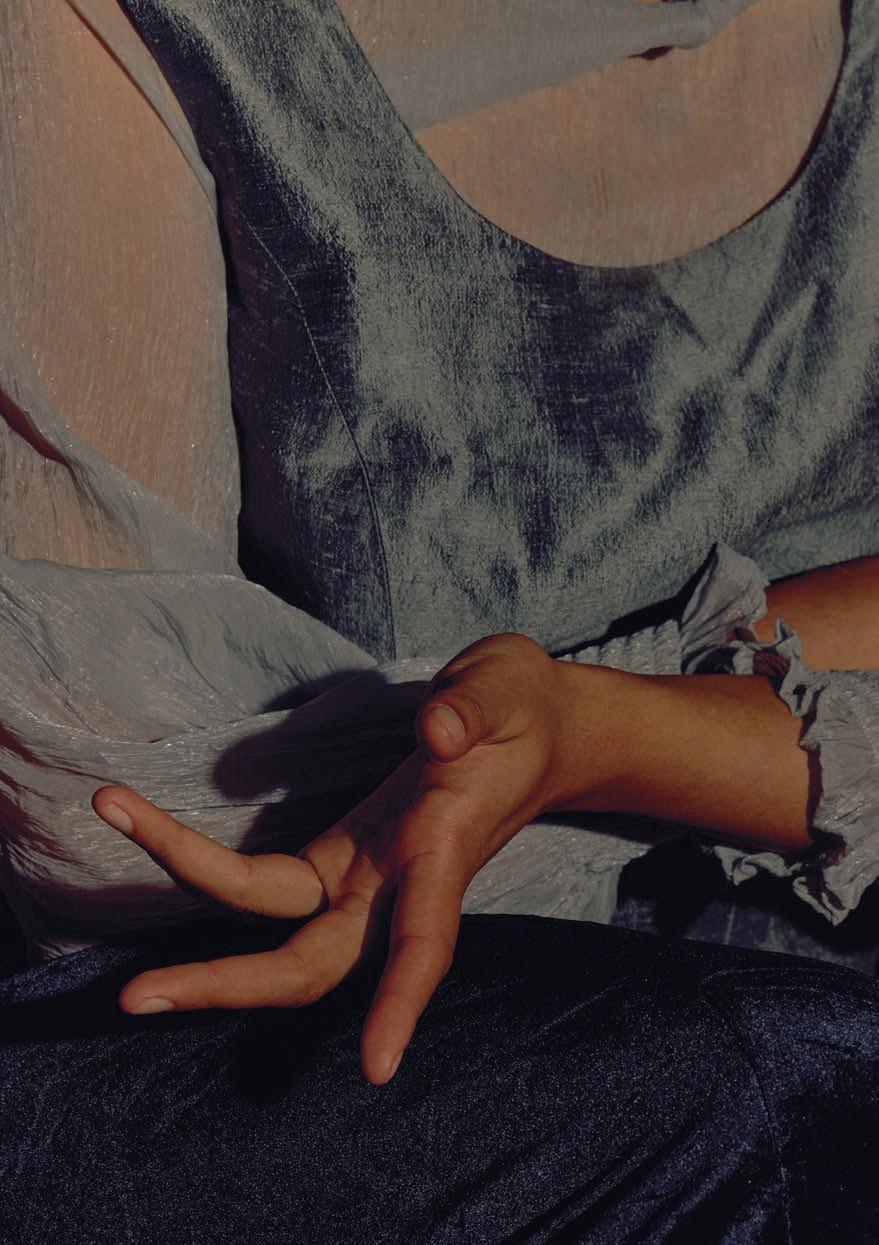










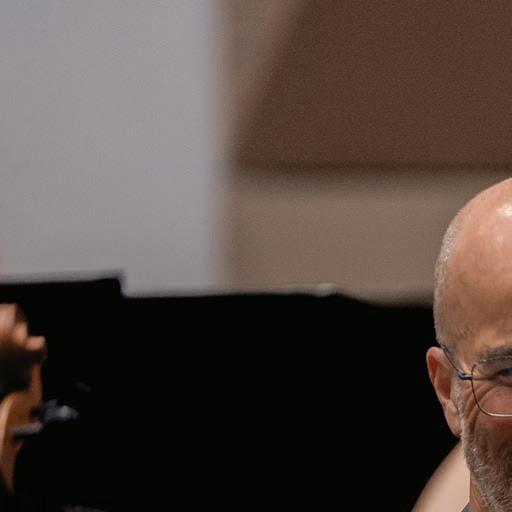

Extend your musical journey through the MSO’s Patron Program.
An annual donation of $500 or above brings you closer to the music and musicians you love. Enjoy behindthe-scenes experiences and exclusive gatherings with MSO musicians and guest artists, while building social connections with other music fans and directly supporting your Orchestra.

Scan the QR code to become an MSO Patron today.
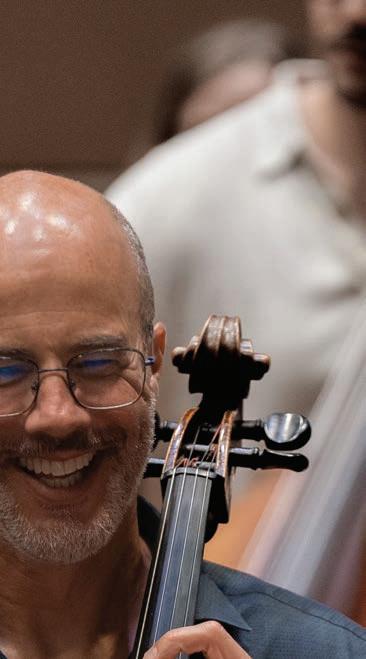

In the first project of its kind in Australia, the MSO has developed a musical Acknowledgment of Country with music composed by Yorta Yorta composer Deborah Cheetham Fraillon AO, featuring Indigenous languages from across Victoria. Generously supported by Helen Macpherson Smith Trust and the Commonwealth Government through the Australian National Commission for UNESCO, the MSO is working in partnership with Short Black Opera and Indigenous language custodians who are generously sharing their cultural knowledge.
The Acknowledgement of Country allows us to pay our respects to the traditional owners of the land on which we perform in the language of that country and in the orchestral language of music.

As a Yorta Yorta/Yuin composer the responsibility I carry to assist the MSO in delivering a respectful acknowledgement of country is a privilege which I take very seriously. I have a duty of care to my ancestors and to the ancestors on whose land the MSO works and performs.
As MSO continues to grow its knowledge and understanding of what it means to truly honour the First people of this land, the musical acknowledgment of country will serve to bring those on stage and those in the audience together in a moment of recognition as as we celebrate the longest continuing cultures in the world.
– Deborah Cheetham Fraillon AO
Our musical Acknowledgment of Country, Long Time Living Here by Deborah Cheetham Fraillon AO, is performed at MSO concerts.



Committed to shaping and serving the state it inhabits, the Melbourne Symphony Orchestra is Australia’s preeminent orchestra and a cornerstone of Victoria’s rich, cultural heritage.
Each year, the MSO and MSO Chorus present more than 180 public events across live performances, TV, radio and online broadcasts, and via its online concert hall, MSO.LIVE, engaging an audience of more than five million people in 56 countries. In 2024 the organisation will release its first two albums on the newly established MSO recording label.
With an international reputation for excellence, versatility and innovation, the MSO works with culturally diverse and First Nations artists to build community and deliver music to people across Melbourne, the state of Victoria and around the world.
In 2024, Jaime Martín leads the Orchestra for his third year as MSO Chief Conductor. Maestro Martín leads an Artistic Family that includes Principal Conductor Benjamin Northey, Cybec Assistant Conductor Leonard Weiss CF, MSO Chorus Director Warren Trevelyan-Jones, Composer in Residence Katy Abbott, Artist in Residence
Erin Helyard, MSO First Nations Creative Chair Deborah Cheetham Fraillon AO, Young Cybec Young Composer in Residence Naomi Dodd, and Artist in Association Christian Li.
The Melbourne Symphony Orchestra respectfully acknowledges the people of the Eastern Kulin Nations, on whose un‑ceded lands we honour the continuation of the oldest music practice in the world.
Tair Khisambeev
Acting Associate Concertmaster
Di Jameson OAM and Frank Mercurio#
Anne-Marie Johnson
Acting Assistant Concertmaster
David Horowicz#
Peter Edwards
Assistant Principal
Margaret Billson and the late Ted Billson#
Sarah Curro
Dr Harry Imber#
Peter Fellin
Deborah Goodall
Karla Hanna
Lorraine Hook
Kirstin Kenny
Eleanor Mancini
Anne Neil#
Mark Mogilevski
Michelle Ruffolo
Anna Skálová
Kathryn Taylor
Matthew Tomkins
Principal
The Gross Foundation#
Monica Curro
Assistant Principal
Dr Mary Jane Gething AO#
Mary Allison
Isin Cakmakçioglu
Tiffany Cheng
Glenn Sedgwick#
Freya Franzen
Cong Gu
Newton Family in memory of Rae Rothfield#
Andrew Hall
Robert Macindoe
Isy Wasserman
Philippa West
Andrew Dudgeon AM#
Patrick Wong
Cecilie Hall#
Roger Young
Shane Buggle and Rosie Callanan#
Christopher Moore
Principal
Di Jameson OAM and Frank Mercurio#
Lauren Brigden
Katharine Brockman
Anthony Chataway
William Clark
Morris and Helen Margolis*
Aidan Filshie
Gabrielle Halloran
Jenny Khafagi
Fiona Sargeant
David Berlin
Principal
Rachael Tobin
Associate Principal
Anonymous#
Elina Faskhi
Assistant Principal
Di Jameson OAM and Frank Mercurio#
Rohan de Korte
Andrew Dudgeon AM#
Sarah Morse
Rebecca Proietto
Peter T Kempen AM#
Angela Sargeant
Caleb Wong
Michelle Wood
Andrew and Judy Rogers#
Jonathon Coco
Principal
Stephen Newton
Acting Associate Principal
Benjamin Hanlon
Acting Associate Principal
Di Jameson OAM and Frank Mercurio#
Rohan Dasika
Acting Assistant Principal
Suzanne Lee
Learn more about our musicians on the MSO website. # Position supported by
Prudence Davis Principal Jean Hadges#
Wendy Clarke
Associate Principal
Sarah Beggs
PICCOLO
Andrew Macleod Principal
OBOES
Michael Pisani Acting Principal
Ann Blackburn
COR ANGLAIS
Rachel Curkpatrick Acting Principal
CLARINETS
David Thomas Principal
Philip Arkinstall Associate Principal
Craig Hill
Rosemary and the late Douglas Meagher#
BASS CLARINET
Jonathan Craven Principal
Jack Schiller
Principal
Dr Harry Imber#
Elise Millman
Associate Principal
Natasha Thomas
Patricia Nilsson and Dr Martin Tymms#
Brock Imison Principal
HORNS
Nicolas Fleury Principal
Margaret Jackson AC#
Peter Luff
Acting Associate Principal
Saul Lewis
Principal Third
The late Hon Michael Watt KC and Cecilie Hall#
Abbey Edlin
The Hanlon Foundation#
Josiah Kop
Rachel Shaw
Gary McPherson#
Owen Morris Principal
Shane Hooton
Associate Principal
Glenn Sedgwick#
Rosie Turner
John and Diana Frew#
Richard Shirley
BASS TROMBONE
Michael Szabo Principal
TUBA
Timothy Buzbee Principal
TIMPANI
Matthew Thomas Principal
PERCUSSION
Shaun Trubiano Principal
John Arcaro
Tim and Lyn Edward#
Robert Cossom
Drs Rhyl Wade and Clem Gruen#
HARP
Yinuo Mu Principal
ARTISTS
Melbourne Symphony Orchestra
Benjamin Northey conductor^
Steven Isserlis cello
^Nodoka Okisawa is unable to conduct this program as originally scheduled.
PROGRAM
AKUTAGAWA Triptyque for String Orchestra [13']
SHOSTAKOVICH Cello Concerto No.1 [28']
– Interval –
NAOMI DODD* RUN** [10']
PROKOFIEV Symphony No.7 [31']
*Cybec Young Composer in Residence
**World premiere of an MSO Commission
CONCERT EVENTS
PRE-CONCERT TALK
Want to learn more about the music being performed? Arrive early for an informative and entertaining pre-concert talk with ABC Classic presenter
Stéphanie Kabanyana-Kanyandekwe and Cybec Young Composer in Residence
Naomi Dodd.
3 & 5 October at 6.45pm in the Stalls Foyer on Level 2 at Hamer Hall.
For a list of musicians performing in this concert, please visit mso.com.au/musicians
Duration: 2 hours including interval. Timings listed are approximate.
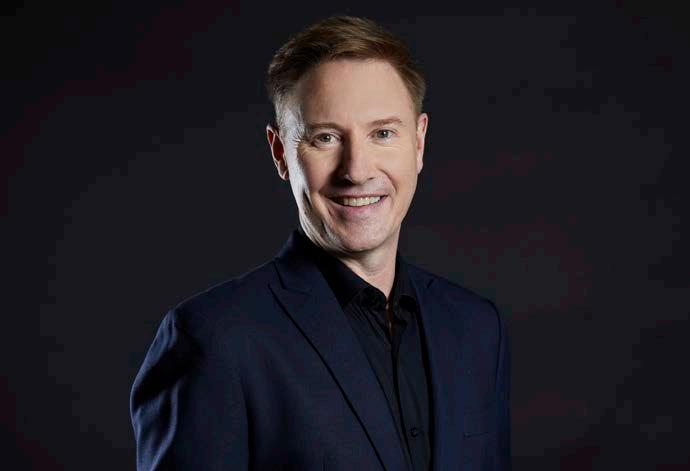
PRINCIPAL CONDUCTOR AND ARTISTIC ADVISOR – LEARNING AND ENGAGEMENT
Australian conductor Benjamin Northey is the Chief Conductor of the Christchurch Symphony Orchestra and the Principal Conductor and Artistic Advisor – Learning and Engagement of the Melbourne Symphony Orchestra.
Northey studied conducting at Finland's Sibelius Academy with Professors Leif Segerstam and Atso Almila and completed his studies at the Stockholm Royal College of Music with Jorma Panula in 2006.
Northey appears regularly as a guest conductor with all major Australian symphony orchestras, Opera Australia (La bohème, Turandot, L’elisir d’amore, Don Giovanni, Così fan tutte, Carmen), New Zealand Opera (Sweeney Todd ) and the State Opera South Australia (La sonnambula, L’elisir d’amore, Les contes d’Hoffmann).

Acclaimed worldwide for his technique and musicianship, cellist Steven Isserlis enjoys a uniquely varied career as a soloist, chamber musician, recording artist, educator, author and broadcaster. He appears with the world’s leading orchestras and conductors, and gives recitals in major musical centres. As a chamber musician has curated concert series for many prestigious venues. Since 1997, he has been artistic director of the International Musicians Seminar at Prussia Cove, Cornwall.
The recipient of many awards, his honours include a CBE in recognition of his services to music, the Schumann Prize of the City of Zwickau, the Piatigorsky Prize and Maestro Foundation Genius Grant (USA), the Gold Medal awarded by the Armenian Ministry of Culture, the Glashütte Original Music Festival Award (Germany), and the Wigmore Medal (UK).
Steven plays the ‘Marquis de Corberon’ Stradivarius of 1726, on loan from the Royal Academy of Music.
Triptyque for String Orchestra
I. Allegro
II. Berceuse (Andante)
III. Presto
Triptyque was written on the commission of Austrian conductor Kurt Wöss, who was then Principal Conductor of the NHK Symphony Orchestra in Japan. Wöss gave its premiere with the New York Philharmonic at Carnegie Hall in December 1953, and the score was subsequently published in the Soviet Union after Akutagawa’s visit there between 1954 and 1955.
Akutagawa had taken the title of his work from Polish-born composer Alexandre Tansman’s Triptyque (1930). The idea of a triptych indeed informs Akutagawa’s conception of the work: although the three movements in Triptyque are separate, they are intrinsically linked through the repeated use of the opening rhythmic figure. The vibrant first movement starts off by presenting this propulsive rhythmic figure that permeates through the texture. While the second-movement Berceuse (lullaby) exhibits a sharp contrast with the first movement, the rhythmic figure has nevertheless remained an integral part of the lyrical theme. Its presence is also highlighted by means of a special playing technique, where the cello- and violaplayers are asked to knock on the body of their instruments. The third movement then brings back the rhythmic figure in its reversed form, and this infuses the music with the momentum that drives towards a festive end.
© Kelvin H. F. Lee 2021 (originally commissioned for the BBC Scottish Symphony Orchestra)
Cello Concerto No.1 in E flat, Op.107
I. Allegretto
II. Moderato –
III. Cadenza –
IV. Allegro con moto Soloist
Steven Isserlis cello
Mstislav Rostropovich was faced with a dilemma. He was keen for Shostakovich to compose a cello concerto but, perhaps all too aware of his friend’s sensitive nature, he had first asked the composer’s wife what it would take to make Dmitri write one. She advised him that one should never ask (and certainly not beg) her husband to write anything. Rostropovich followed her advice and made no requests to the composer, but sometime later, in 1959, reading the Soviet Art newspaper he discovered that Shostakovich had indeed written a concerto. Soon the cellist was playing through the new work with pianist Alexander Dedyukhin in the presence of the composer, who asked insistently if they liked the music. Once Rostropovich was able to convince him how moved he had been from the first note, Shostakovich humbly asked permission to dedicate his first cello concerto to him. (Shostakovich’s second cello concerto, overtly less virtuosic than the first, was also written specifically for the Russian master cellist, in 1966, and exploited Rostropovich’s genius as an interpretive musician.)
In the E flat concerto, Shostakovich uses almost every sound the cello can make to overcome the difficulties posed by a form composers often avoid. Being a mid-range instrument, the cello is easily swamped when pitted against a full orchestra, and listening to how Shostakovich responds to this challenge
affords almost as much pleasure as his passionate writing for the instrument.
For example, Shostakovich starts by toning down the orchestra, using only double woodwind with piccolo and contrabassoon, one horn, celeste, timpani and strings, and the way he writes for this ensemble is reminiscent of his chamber music. The opening has touches of Stravinsky’s early Neoclassical works. The cello announces the four-note theme that will bind the entire concerto together, and is answered by the winds in a Baroque figure in the home key. The main cello motif (G – E –B – B flat) contains two notes (E and B) which are not in the key of E flat, thus reinforcing the feeling of Stravinskian ‘wrong-note’ harmony.
Shostakovich’s own unmistakable musical personality, however, is soon in evidence. Allowing room for the soloist, the orchestral textures are widely spaced, with high woodwind and deep double basses and contrabassoon creating a dark and distinctly Russian feel. The absence of heavy brass highlights the lone horn whose solo roles throughout the concerto provide a beautiful timbral counterpoint to the cello, often reiterating the soloist’s themes.
The second movement—an A minor moderato—begins with strings in a more Romantic, almost Mahlerian vein. This chromatic, smoothly contoured theme is heard only three times, virtually unchanged and acting as a hinge upon which the movement turns. Its initial exposition is halted by the horn, whose repeated melodic fragment turns out to be a gentle fanfare announcing the solo cello. The subsequent lyrical, drawnout melody inevitably leads back to the string theme, transposed higher and this time reaching a kind of climax. It will return once more before we hear the movement’s highlight: the soloist’s stratospheric harmonics accompanied
by quiet, shimmering strings and the celeste in its only appearance in the score. A solo clarinet takes over from the celeste in an ethereal duet with the cello over plucked bass notes leading straight into the cadenza.
Essentially a link between the slow movement and the finale, the cadenza appropriately has the feel of an improvisation. The soloist shows off a dazzling array of cello techniques in the midst of rapid runs and double stops punctuated by still pizzicato chords. From here, Shostakovich builds cleverly towards the finale, the orchestra entering suddenly with huge chords. They set the dramatic pace for the music ahead which gallops with a folk-like energy towards a final combination of the opening motif from the first movement with the finale’s own two themes. The whole work comes to a crashing end with the timpani, repeating what was once the Baroque answering figure in the woodwinds, and transforming it into an emphatic full-stop.
Rostropovich’s premiere of the work in October 1959 was an unqualified success, and he toured it in the following months to the UK, the US and Australia where it met with popular and critical success, despite its Soviet origins (this was still the Fifties, after all). Undaunted by the Russian cellist’s reputation, other soloists have since taken it up eagerly, cementing its place in both the repertoire, and in audiences’ hearts.
Drew Crawford © 1998
(b. 1997)
The composer writes:
Why does music that is frightening not make me feel afraid, but rather, empowered? From a place of safety, l am drawn towards the imaginary, the fantastic, the fearsome. A quickened heart rate, a spike in adrenaline, my senses on edge—is it terror, or excitement?
For this work, I wanted to write a dramatic composition using the full force of the orchestra, to create a musical experience where people can process big emotions, making them feel empowered and strong!
As well as being influenced by composers such as Prokofiev and Stravinsky, I was also inspired by modern works such as Nautilus by Anna Meredith and different styles of music such as electronic dance music or “EDM”. By incorporating influences from this modern popular style of music, I seek to engage people who might not typically listen to classical music and challenge their preconceptions of what classical music sounds like. In my work you will hear a constant driving pulse, energetic cross-rhythms and even a bass drop!
For me, composing music is a release of my deepest, sometimes intangible thoughts and feelings. I hope that my music will, in turn, enable listeners to connect to their own deep emotions while being captivated and moved by the melodies, textures and colours brought to life by the orchestra.
Run with me, push faster, feel this power and behold the energy of the converging orchestral forces, and then—RUN.
(1891–1953)
Symphony No.7 in C sharp minor, Op.131
I. Moderato
II. Allegretto
III. Andante espressivo
IV. Vivace
Sergei Prokofiev’s Seventh Symphony, completed in 1952, a year before his death, was one of his last works. Controversially, a number of compositions from his final years have had an uneasy history. Some have asserted that these late works are weak, that they portray a composer—by then frail from illness and increasingly impoverished—who possessed little of his former skills. As a recent example, Dorothea Redepenning writes in New Grove: ‘The late instrumental works are curiously colourless, and conspicuous for an almost excessive tendency to simplicity; there is nothing here of the lively nonconformity of the young Prokofiev.’ Others have been even less complimentary. About his final symphony, the composer similarly indicated reservations when, during a rehearsal, he turned to his companions and asked ‘but isn’t the music rather too simple?’
Yet those with a negative opinion of the Seventh Symphony often miss many of its finer nuances, and almost certainly assess the work separately from the circumstances of its composition. With an awareness of the context in which it was written, however, certain aspects of its style and character can be more easily understood. Chief among the factors that contributed to the composer’s difficult final years was a famous resolution on Soviet music in 1948 which attacked Russia’s most gifted composers, of whom Prokofiev was a leading member. Accused of ‘formalism’—an ill-defined notion that,
in its most simplistic reading, related to the use of dissonance, but which could be also levelled as an attack on socialist ideology—his powerful Sixth Symphony was denounced, and his entire output effectively banned from performance. Furthermore, the arrest and incarceration of his foreign-born wife, the deaths of fellow composer and friend, Nikolay Myaskovsky, and film director, Sergei Eisenstein, the subsequent loss of income from performances and prizes, and the rapid erosion of his health, combined to bring about his own death within five years.
In the case of the Seventh Symphony, some of the simplicity for which he has been criticised may stem from its origins as a work intended for the Children’s Radio Division. While some have suggested that writing for a youthful audience may have been an attempt at skirting official censorship, the exact circumstances of its composition are not known. The initial mood of the symphony reveals a stark, and mature, reality, with the plaintive writing at times pared back to just two lines. The wintry tone is soon broken by a theme of extraordinary warmth, the soaring melody being lent a sense of elevation by its rippling accompaniment. A curiously tinkling motif follows in flute and glockenspiel, recalling the magical soundscapes so common to Russian music since the time of Glinka. The instrumentation also draws to mind a ticking clock, an effect that Shostakovich was to use in his final symphony. Perhaps advisedly, Prokofiev proceeds with a typically ‘classical’ development of the material, marking one of the few instances where he adheres to the archaic ‘sonata form’. The themes are again presented, before the movement ends quietly with an unexpected return to the colder tonality of the opening.
The bright and capricious Allegretto movement immediately brings to mind
the composer’s earlier forays into ironical waltzes. As the movement progresses, however, focus is drawn increasingly to the recurrence of fateful pounding rhythms and seemingly portentous moments of subdued orchestration, such as in the theme of the repeated trio section, scored for muted strings. The slow movement revisits a melody that Prokofiev had composed for a theatrical adaptation of Pushkin’s Yevgeny Onegin in 1936. The production never took place, however, as its director, Sigizmund Krzhizhanovsky, fell out of favour— perhaps ominously—with Soviet authorities. The short theme is the basis of numerous variations, each utilising an ever wider palette of orchestral colours, and in increasingly disparate keys. Adding contrast is a simple, childlike tune, introduced by the oboe.
The final movement seems most easily identifiable with the audience originally designated for the work, as it noisily bursts forth in a sprightly gallop. A yearning subsidiary theme leads to a playful march, recalling the humour of an earlier youth-oriented work, Peter and the Wolf. The momentum is ultimately broken by a series of heaving chords, leading to the unexpected re-emergence of the broad-winged theme from the first movement. The tinkling bell motif duly follows, but the alternation between major and minor tonalities creates an impression of bittersweet resignation. On this irresolute point, the symphony was originally intended to close. However, Prokofiev was persuaded to change the ending by writing a few further bars, returning with great optimism to the gallop. For some, a sadly forlorn conclusion might potentially trouble an audience, as the symphony’s first conductor, Samuil Samosud, may have pointed out. At the same time, it is difficult to ignore the composer’s dire financial situation, and the knowledge
that such a change would gain his eligibility for a Stalin Prize First Class, worth some 100,000 rubles. Ultimately, the composer decided not to step entirely away from his earlier plan, and the published score states that performance of either ending is valid. Given the many unanswered, and perhaps unanswerable, questions that still surround Prokofiev—such as how much he truly understood of the events of 1917 when he decided to leave Russia, and why he chose to return in the 1930s, when so many liberties were being curtailed—it is perhaps fitting that the close of his final symphony is similarly enigmatic.
Abridged from Scott Davie © 2009

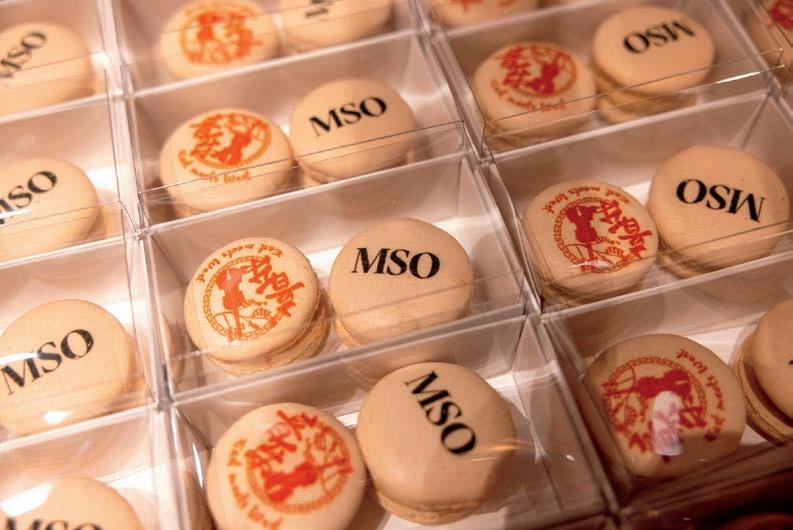



ARTISTS
Melbourne Symphony Orchestra
Fabien Gabel conductor
Alexandra Dariescu piano
PROGRAM
DEBUSSY (arr. Altinoglu) Pelléas and Mélisande: Suite [22']
C. SCHUMANN Piano Concerto [21']
– Interval –
WAGNER Tristan and Isolde: Prelude and Liebestod [17']
R. STRAUSS Die Frau ohne Schatten: Symphonic Fantasy [15']
CONCERT EVENTS
PRE-CONCERT TALK
Want to learn more about the music being performed? Arrive early for an informative and entertaining pre-concert talk with Karen van Spall.
10 October at 6.45pm in the Stalls Foyer on Level 2 at Hamer Hall.
12 October at 1.15pm in the Stalls Foyer on Level 2 at Hamer Hall.
For a list of musicians performing in this concert, please visit mso.com.au/musicians
Duration: 1 hour and 45 minutes including interval. Timings listed are approximate.
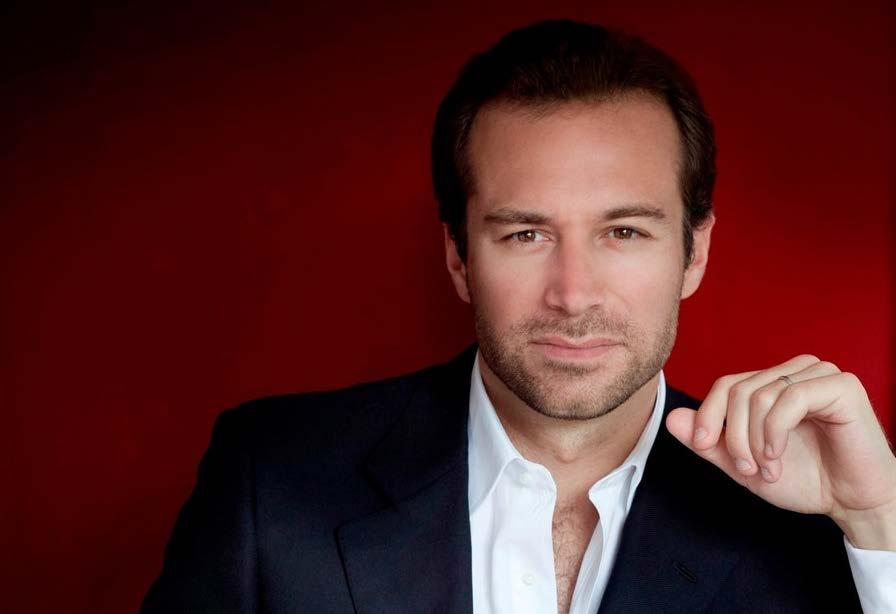
Fabien Gabel is the newly appointed Music Director Designate of the TonkünstlerOrchester, beginning in the 2025/2026 season. Elsewhere, he has established an international career of the highest calibre, appearing with orchestras such as London Philharmonic Orchestra, Orchestre National de France, NDR Elbphilharmonie Orchester, Oslo Philharmonic, Royal Stockholm Philharmonic Orchestra, Chicago Symphony, Seoul Philharmonic and Melbourne Symphony Orchestra.
Fabien Gabel performs with soloists such as Daniil Trifonov, Yefim Bronfman, Emmanuel Ax, Jean-Yves Thibaudet, Gidon Kremer, Augustin Hadelich, Vilde Frang, Christian Tetzlaff, Gautier Capuçon, Daniel Mueller-Schott, Emmanuel Pahud, and with singers such as Natalie Dessay and Petra Lang.
Having attracted international attention in 2004 as the winner of the Donatella Flick conducting competition, Fabien Gabel was Assistant Conductor of the London Symphony Orchestra 2004–2006. He was music director of Orchestre symphonique de Québec 2012–2021 and Orchestre Français des Jeunes 2017–2021.
Fabien Gabel was named ‘Chevaliers des Arts et des Lettres’ by the French government in January 2020.
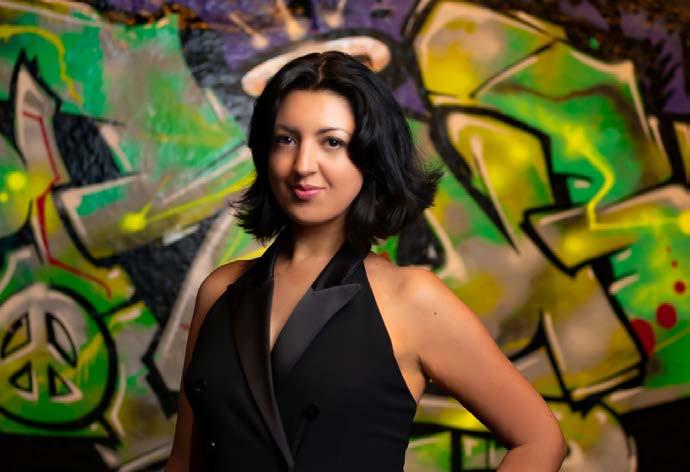
Alexandra Dariescu is a trailblazing pianist who demonstrates fearless curiosity in performing diverse and thought-provoking programmes. Dariescu has performed with eminent orchestras such as Orchestre National de France, London Philharmonic Orchestra, Sydney Symphony Orchestra, the Oslo and Copenhagen Philharmonics, alongside conductors such as Ádám Fischer, Sakari Oramo, John Storgårds, Fabien Gabel and Alain Altinoglu.
In 2017, Dariescu took the world by storm with her piano recital production “The Nutcracker and I”, a ground-breaking multimedia performance for piano solo with dance and digital animation. Recent milestones include opening the 2023/24 season for the BBC Symphony Orchestra in the UK premiere of Dora Pejačević’s Phantasie Concertante and the world premiere of a new piano concerto written for her by James Lee III— Shades of Unbroken Dreams—with the Detroit Symphony and BBC Philharmonic orchestras.
Dariescu has released nine albums to critical acclaim, the latest being the Clara Schumann and Grieg Piano Concertos with the Philharmonia Orchestra and Tianyi Lu.
Dariescu is a Laureate at the Verbier Festival Academy and from September 2024, she assumes the role of Professor of Piano at London’s Guildhall School of Music and Drama.
Pelléas and Mélisande: Suite
Like Wagner, Debussy preferred the “lucid exposition of inner motives” to historical incident and physical action in a music drama. In June 1885 he wrote to his patron Eugène Vasnier: “I would always prefer something in which, in some way, action would be sacrificed to the long-pursued expression of the feelings of the soul.”
Debussy found what he was looking for when he attended a performance of Maurice Maeterlinck’s play Pelléas et Mélisande in May 1893. He began sketching ideas for an opera on the subject almost immediately, and when he received Maeterlinck’s permission to use the play he made very few cuts.
Debussy worked at his opera fairly steadily for two years (during which he also completed the Prélude à l’après midi d’un faune), though not without numerous starts and stops. In October 1893, for example, he wrote to the composer Ernest Chausson: “I was hasty in singing a victory song for Pelléas et Mélisande as, after one of those sleepless nights that always is a good counselor, I had to recognize that this wasn’t it at all. The thing resembled a duo of Mr. So-and-So, or it doesn’t matter whom, and most of all the ghost of Old Klingsor, alias R. Wagner, appeared at the turn of a measure. So I tore everything up and struck out searching for a new chemistry of more personal phrases, and strove to become as much Pelleas as Melisande... Quite spontaneously I’ve made use of a means of expression that seems to me quite special, which is silence—Don’t laugh! It acts as an agent of expression and perhaps is the only means of giving
full value to the emotion of a phrase.”
One of the things Debussy did to support himself while composing Pélleas was to play Wagner’s scores—including Tristan—on the piano for private salons. There are many points of connection between Tristan and Pélleas besides the love-and-betrayal storyline, including Debussy’s own highly idiosyncratic use of identifying leitmotifs.
But there are at least as many points of departure, beginning with the use of the French language—Wagner was horrified by the thought of Tristan translated into French—and Debussy’s one-syllable-per-note respect for its inflections. Then there is Debussy’s revolutionary use of silence in many contexts, a psychologically expressive and structurally articulate silence.
Debussy had the vocal score largely completed by the summer of 1895. In the years before Pelléas was finally staged at the Opéra-Comique in 1902, there was much interest in the score among French musicians. Debussy was very reluctant, however, to let the music be heard out of context. He vetoed the idea of concert selections, writing in October 1896 that in such circumstances “you could not hold it against anyone for not understanding the special eloquence of silences, with which the work is star-studded.”
Once the work was well-established— having been performed 100 times in Paris within its first ten years—Debussy was less paranoid about sampling it in concert. After his death several adaptations for orchestra were made, including including this recent version by French conductor Alain Altinoglu. One of the problems confronting Debussy during rehearsal was that he had not allowed enough time for scene changes, so he had to create or extend orchestral interludes in several places.
© John Henken. Reprinted by permission of the author and the Los Angeles Philharmonic.
CLARA SCHUMANN (1819–96)
Piano Concerto in A minor, Op.7
I. Allegro maestoso
II. Romanze (Andante non troppo con grazia)
III. Finale (Allegro non troppo)
Soloist
Alexandra Dariescu piano
On 9 November 1835, Felix Mendelssohn conducted the Gewandhaus Orchestra in the world premiere of Clara Wieck’s Piano Concerto in A minor, with the sixteen-year-old composer as soloist. Clara was a lifelong admirer of Mendelssohn—as Robert Schumann later grumbled, she would ‘glow for hours after a nice word from Mendelssohn’. And indeed, this early concerto reveals even more of Mendelssohn’s influence than it does of Schumann’s.
However, Robert Schumann, who had been living with the Wieck family, was never far away. It was he who had orchestrated the third movement two years earlier, when Clara composed it to stand alone as a Concertsatz. She subsequently added the first two movements, and orchestrated them herself.
The work is an extraordinary achievement for a teenager, particularly as she had never previously composed anything other than miniatures. Like the young Fanny Mendelssohn, Clara Wieck was the beneficiary of an unusual musical education, in this case from her father, the renowned piano pedagogue Friedrich Wieck. Unlike Fanny Mendelssohn, however, Clara was encouraged into the public sphere from an early age—indeed, her father’s finances depended on it. By the time of this concerto, she had been hailed around Europe as a virtuoso of the first order.
The concerto reveals Clara Wieck’s tremendous pianistic culture, and her power as an improviser. It is an exuberant work, and speaks of a young woman’s intoxication with her own abilities. As in Mendelssohn’s earlier concerto in G minor, the movements run through to each other. And while the piano part is composed in bravura, virtuoso style, there are no explicit piano cadenzas.
The first movement consists of only an exposition and development, before setting up the second movement with a modulation to A flat major. Such a modulation was still shocking for the time, and attributable by at least one reviewer to the ‘moods of women’. The slow movement affords a break for the orchestra, and unfolds as a song without words for solo piano, finally joined in its ‘Romance’ by the cello. (There is a clear reference to this pairing in Schumann’s piano concerto of 1845, and perhaps also in the second piano concerto of Clara’s other great admirer, Brahms, which appeared nearly fifty years later.) The third movement, a Polonaise, is the most substantial of the three, and the movement in which the piano most fully engages with the orchestra.
Robert Schumann anonymously and rather purple-ishly celebrated the concerto’s premiere in his journal, the Neue Zeitschrift für Musik:
What we first heard took flight before our eyes like a young phoenix soaring up from its own ashes. Here white yearning roses and pearly lily calyxes inclined their heads; there orange blossoms and myrtle nodded, while alders and weeping willows spread out their shadows…I often spied little boats, hovering daringly over the water…
Shortly after this review, Robert and Clara declared their love, much to the dismay of Friedrich Wieck. Robert then allowed himself to be more succinct about the concerto, in a letter:
‘There are brilliant ideas in the first movement yet it did not make a complete impression on me.’
Clara protested: ‘Do you think I am so unaware that I don’t know the faults of the concerto? I know them well, but the people in the audience don’t know them, and they don’t need to know them.’
Indeed, this concerto remained a successful part of Clara’s touring repertory, until she stopped performing it after her marriage—perhaps because of Robert’s increasingly puritanical views on composer-virtuosos. But the concerto was published in 1837, and continued to sell throughout the nineteenth century. And despite his reservations, Robert Schumann’s own concerto in A minor, of 1845, bears more than a passing resemblance to the work.
Certainly, the concerto indicates much early promise, and can stand proud alongside the early works of more celebrated composers. However, after her marriage, Clara Schumann’s compositional ambitions dwindled. She occasionally presented a piece to her husband, with apologia for her ‘renewed feeble attempts’. But four years after the concerto’s premiere, she wrote that:
‘I once believed that I had creative talent, but I have given up this idea; a woman must not wish to create— there never was one able to do it… May Robert always create; that must always make me happy.’
© David Garrett 2005
RICHARD WAGNER (1813–83)
Tristan and Isolde: Prelude and Liebestod
Die Walküre is often considered the perfect embodiment of the operatic theories Wagner espoused in his book Oper und Drama (1851). In 1851 he had
argued for a balanced relationship between words and music. 1865’s Tristan und Isolde, however, can be listened to almost purely as music. What had caused the elevation of music’s role?
Wagner conceived an opera on the Tristan myth in 1854, around the time of the first complete musical draft of Die Walküre. He interrupted composition on Siegfried, the third opera of his Ring cycle, to compose the music for this work.
Why the interruption? Partly he wanted to give expression to a passion he had conceived for Mathilde Wesendonck, the wife of a Zurich silk merchant. And Tristan could indeed be considered opera’s ‘greatest love story ever told’. But there were philosophical considerations as well.
Tristan und Isolde begins with Tristan taking the sorceress Isolde back to Cornwall to wed his uncle, King Marke. But he and Isolde fall into a world-defying love when Isolde’s servant substitutes a love potion for the poison Isolde intended for Tristan. When they are caught, Tristan flees, mortally wounded. He dies as Isolde comes to him, and she expires in expectation of joining him beyond earthly life. This all takes place with a minimum of action, dramatic incident stripped down basically to entrances and exits. Act II is essentially one long love duet.
But Tristan und Isolde is not simple in philosophical or psychological terms. Another reason for Wagner’s interruption from The Ring was the influence on him of Arthur Schopenhauer (1788–1860), whose quasi-Buddhist philosophy he needed to digest. Schopenhauer held that music allowed the individual to inhabit ‘will’ itself, rather than sit in the world buffeted by the will’s manifestations. Music was thus the principal art form, a problematic position for a composer who had argued for an equal synthesis of all the arts. In a sense,
composing Tristan was a method of solving this problem. Not that Wagner completely retreated from dramatic intention. Rather, he had found that music, as ‘will’, gave rise to action; action, not text, was music’s new partner.
Following Schopenhauerian thought on transcendence, Wagner gained new insight into his continuing concerns with Romantic ‘love and death’. Isolde, in her ‘love-death’, finally transcends the suffering of her lover’s death and finds fulfilment in a mythical realm.
In trying to convey all this, Wagner almost exhausted Western harmony’s unique ability to express longing. The Prelude begins with four notes of cello in a yearning arc which culminates in the famous ‘Tristan’ chord, a tensely knotted harmony, which unfurls to a merely less dissonant chord. This is the pattern of tension and not-quite release for the next five hours of the opera (and certainly the Prelude).
In concert, the Prelude is often paired with the opera’s very end, the Liebestod, Isolde’s final monologue. This is less dissonant yet still constantly modulating, and thus unsettled. Its melody derives from Act II where Tristan sang: ‘Thus might we die, undivided …’ In Act II, the build-up culminated in an ugly interrupted cadence. Here, finally, there is complete release as Isolde sings of tasting Tristan’s respiration in ‘sweet perfume, in the surging swell, in the ringing sound of the world’s breath’—a flood of sensation suggesting transcendence beyond surfeit.
‘Even if only one person pays for a seat at Tristan, it must be performed for him …’, said Richard Strauss.
© Gordon Kalton Williams 2012
Die Frau ohne Schatten: Symphonic Fantasy
Richard Strauss, then 35, met the upand-coming young writer Hugo von Hofmannsthal, ten years his junior, in 1899, but it was after seeing a stunning performance of Hofmannsthal’s play Elektra, based on the ancient Greek myth, in 1905 that he approached the playwright with collaboration in mind. So began the complicated and by turns fruitful and frustrating working relationship that would result not only in the masterpieces Elektra and Der Rosenkavalier but also such works as the ballet Josephslegende and Der Bürger als Edelmann. The collaboration remained intense from Elektra through about 1917, when Strauss put the finishing touches on the opera Die Frau ohne Schatten. After a hiatus, they worked together again on Die ägyptische Helena (“The Egyptian Helen,” first produced in 1928) and, finally, Arabella, which Strauss completed after Hofmannsthal’s death in 1929.
The sources of these librettos include ancient Greek tragedy, the Hebrew Bible, French comedies of manners, and, for Die Frau ohne Schatten, fairy tale, reflecting Hofmannsthal’s mystic, classicist, and modernist tendencies. Decidedly fixed in early 20th-century aesthetics are the psychological and realist subtleties of characters that reflect the broad outlines of archetypes, whether of the old commedia dell’arte sort or of the Freud/Jung categories that were very much current in the first decades of the century. In Die Frau ohne Schatten, the role-names define the characters’ life status, not their individuality: Emperor and Empress, Nurse, Dyer, and Female Dyer, usually referred to in English as the Dyer’s Wife. (The Dyer does have a name, Barak,
but his identity as a tradesman and merchant are central to the role.) The narrative’s geography is also archetypal, stratified into the realms of the spirit world (i.e., heaven), the in-between realm of the Emperor and Empress, and finally the lower depths: earth, inhabited by rough, flawed mortals who toil for a living. Also, the theme of redemption through self-abnegation and sacrifice is itself a universal narrative.
The initial basis for the libretto was a fairy tale by Wilhelm Hauff (1802–1827), “The Stone Heart,” the fantastic and down-to-earth elements of which appealed to Strauss. According to Strauss biographer Norman Del Mar, Hofmannsthal had hopes of delivering the libretto quickly, but its complex network of allegory and symbolism required several years to work out. Strauss finally completed Frau in summer 1917, but the recent war’s spectre delayed the premiere of this opulent opera for another two years.
The Woman Without a Shadow is the Empress, a semi-divine being who was wooed by the mortal Emperor. For her, a shadow represents a soul as well as fertility and mortality. Her father is an unseen divinity who deems that if she doesn’t acquire a soul within a year (of which three days remain), her Emperor will be turned to stone. Her guardian, the Nurse, reveals that the Empress can acquire a soul from a mortal; if this happens, though, she—as well as the Nurse—will be denied re-entry to the spirit world. They travel to earth, where dwells a mortal pair complementing the Empress and Emperor, the gentle Färber and his restless, frustrated wife, the Färberin (from the German “Farbe,” for colour; both words mean “textile dyer”). The plot revolves around the machinations of the Empress and Nurse to acquire the Dyer’s Wife’s shadow/ soul, but the Empress ultimately must find a more transcendent path.
The Symphonic Fantasy on Die Frau ohne Schatten was an act of practical salvage. Just after World War II the composer was nearly persona non grata, ostensibly for not having fully condemned Hitler’s Nazi program. While Strauss—who turned 70 in 1934—was not directly complicit with the regime, his voice as an artist of significance was deemed insufficiently loud in opposition to the Third Reich’s oppressive practices. Just after the war he spent an extended period in Switzerland, aware that his comfortable Munich home had been commandeered, performances of his music had all but dried up, and his resources were dwindling. It being easier to interest orchestras and promoters in unperformed works than in older scores, Strauss kept in touch with his conductor allies, offering them new works as he produced them. Several of these “new” scores were reconfigurations of decades-old music.
The Symphonic Fantasy on Die Frau ohne Schatten was relatively brief, employed a smaller, more manageable orchestra than did the opera, and contained music that was unfamiliar enough to be novel. It also gave new life to music from the opera that the composer found compelling, notably concentrating on the mortals and their relationships. Writing to a grandson in summer 1946, Strauss stated, “In the meantime, at the request of my new, very capable London publisher Boosey & Hawkes, I have put together an orchestral fantasia from the best parts of Die Frau ohne Schatten, which should make the work somewhat more popular in concert, since opera performances will probably remain impossible for some time to come. You see, one can still accomplish something worthwhile before one’s 82nd birthday if one has been diligent beforehand.”
The Symphonic Fantasy begins with the three-note descending motif in bass
winds intoning “Kaikobad,” naming the Empress’s divine father. This is entwined with a quick motif associated with the Nurse. The main section is based on a melody from an Act I orchestral interlude meant to show the Dyer’s goodness. The shimmering music of the following extended section comes from a scene in which the Nurse shows the Dyer’s Wife the glittering, luxurious world that could be hers if she sold her shadow. This is followed by a lilting theme representing the Dyer’s Wife’s ideal lover conjured up by the Nurse and a passage reconstructing an Act III duet between the Dyer and his wife, solo trombone taking the Dyer’s vocal part. The transformation that the Dyer and his Wife and the Emperor and Empress attain as a reward for self-reflection and self-denial surges through the final orchestral climax.
© Robert Kirzinger 2021. Reprinted by permission of the author and the Boston Symphony Orchestra.




Melbourne Symphony Orchestra
Fabien Gabel conductor
DEBUSSY (arr. Altinoglu) Pelléas and Mélisande: Suite [22']
WAGNER Tristan and Isolde: Prelude and Liebestod [17']
R. STRAUSS Die Frau ohne Schatten: Symphonic Fantasy [15']
Artist biographies and program notes for this performance can be found beginning on page 17.
PRE-CONCERT WINE TASTING
Arrive early to enjoy a wine tasting courtesy of TarraWarra Estate, free for ticket holders.
14 October at 5.30pm in the Stalls Foyer on Level 2 at Hamer Hall.
POST-CONCERT TALK
Want to learn more about the music being performed? Arrive early for an informative and entertaining pre-concert talk with Katharine BartholomeuszPlows & Fabien Gabel
14 October at 7.45pm in the Stalls Foyer on Level 2 at Hamer Hall.
For a list of musicians performing in this concert, please visit mso.com.au/musicians
Duration: 1 hour and 15 minutes, no interval. Timings listed are approximate.
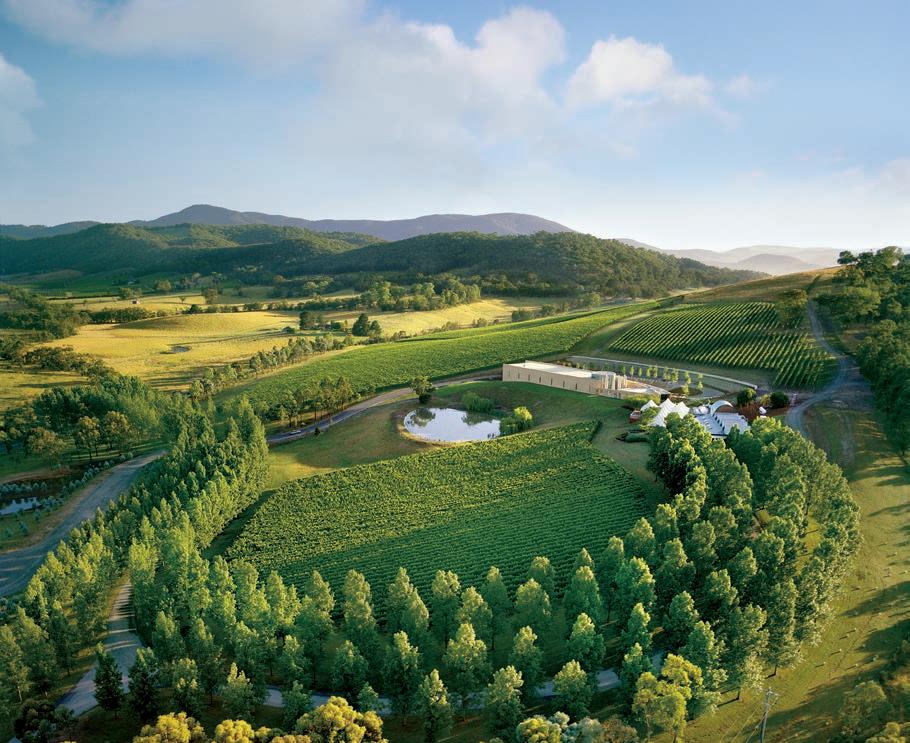

TarraWarra Estate provides you with the perfect backdrop for a day of wine tasting, lunch or simply taking in the views from the deck. Only an hour from Melbourne and you’ll find yourself enjoying our cool climate Chardonnay and Pinot Noir in our subterranean cellar door.
311 Healesville - Yarra Glen Road, Yarra Glen, VIC 3775 Australia +61 3 5962 3311
www.tarrawarra.com.au
_tarrawarra_ /tarrawarra

enq@tarrawarra.com.au
Melbourne Symphony Orchestra
Christopher Moore director / viola
PROGRAM
R. STRAUSS Metamorphosen [26']
– Interval –
SCHOENBERG Transfigured Night [32']
CONCERT EVENTS
PRE-CONCERT TALK
Want to learn more about the music being performed? Arrive early for an informative and entertaining pre-concert talk with pre-concert talk with Andrew Groch and Christopher Moore.
7 November at 6.45pm in the foyer
For a list of musicians performing in this concert, please visit mso.com.au/musicians
Duration: 1 hour and 30 minutes including interval. Timings listed are approximate.

Principal Viola of the Melbourne Symphony Orchestra, Christopher Moore spent nine years travelling the globe as Principal Viola of Australian Chamber Orchestra. As romantic as that sounds, he missed his old chums Mahler, Schoenberg and Adès, and so returned to these and other old friends at the MSO.
Not surprisingly, Christopher’s wife and two daughters are pleased that Papa has hung up his rock star garb and come home to roost like their pet chickens. If you’re lucky, he may hand you a bona fide free-range egg; if you’re unlucky, you’ll be stuck hearing about how much he loves brewing beer and riding his bike into town from the suburbs, in an attempt to prevent his waistline expanding to the size of his chickens’ coop.
Christopher Moore plays a viola attributed to Giovanni Paolo Maggini dating from circa 1600–10 AD, loaned anonymously to the MSO.
Position supported by Di Jameson OAM and Frank Mercurio.
On 12 April 1945, the Berlin Philharmonic Orchestra performed Beethoven, Bruckner and Wagner under the baton of Robert Heger before fleeing their ruined city and the advancing Soviet army. Legend has it that members of the Hitler Youth distributed cyanide capsules to the audience following the concert. Three hundred and fifty miles away, in his villa in Garmisch-Partenkirchen, Richard Strauss put the finishing touches to his last great orchestral score, Metamorphosen—Study for 23 solo strings.
Strauss had declared his composition career over in 1942 with the premiere of his opera Capriccio and described his later works as mere ‘wrist exercises’. History has judged otherwise and his three great last works are characterised by vastly different emotions: the halcyon lyricism and innocence of the Oboe Concerto (1945), the acceptance of death and resolution of the Four Last Songs (1948) and, in Metamorphosen, a profound lament on the wreckage of Germany around him. Strauss had been particularly devastated by the destruction of The Goethehaus in Frankfurt and of his beloved Dresden. On hearing the news of the destruction of the Bavarian National Theater in 1943, Strauss had sketched out 24 bars of music, which he inscribed ‘Trauer um München’ (Mourning for Munich). Although this material was to feature in the work, the composition of Metamorphosen began in earnest when Strauss was the recipient of a commission from the Swiss conductor and benefactor, Paul Sacher, in July 1944. Sacher conducted the Zurich Collegium Musicum in the premiere of the work on
25 January 1946; although Strauss had conducted a number of the rehearsals, he was said to be too emotional to attend the premiere.
The 25-minute score opens with an intensely chromatic figure in the cellos and double basses that appears to rise from the rubble; despite Strauss’ later tonal idiom, 11 of the 12 notes of the scale are heard in first two bars alone. Strauss then lays out his main thematic material in the 4th and 5th violas, a descending melody that resembles the Marcia funebre from Beethoven’s Eroica Symphony. Strauss denied that he consciously quoted the march, claiming that the music ‘escaped my pen’. The second section is heralded by a shift in tonality, from C minor to G major, and a new tempo Etwas fliessender (‘somewhat more lively’). Despite the major key, there is the overriding feeling that there is no release from the darkness and that the music is based in nostalgia rather than hope. The tension rises before Strauss brutally returns to C minor and the opening material, now fortissimo and played by the full ensemble. As the music subsides, it is clear that Strauss’ grief is inconsolable.
On the final page of the score in the cellos and basses, Strauss directly quotes Beethoven’s Funeral March; for added emphasis, he marks the quote ‘In Memoriam!’. Who exactly Strauss included the quote in memory of is not explained. It could be that Strauss, like Beethoven on Napoleon, was marking the passing of his belief in Hitler. It is also credible that the composer of such autobiographical works as Sinfonia Domestica and Ein Heldenleben saw Metamorphosen as a threnody to his own life and work. Most likely is that this masterly composition marks Strauss’ epitaph on the German cultural life in which he had once shone and which had now catastrophically disintegrated.
Huw Humphreys
(1874–51)
Transfigured Night, Op.4
Transfigured Night (Verklärte Nacht), originally composed for string sextet (two each of violins, violas and cellos), was first performed in Vienna in 1902 by the augmented Rosé Quartet. The first audience was baffled, but the work soon became Schoenberg’s most frequently performed music, and remains his most popular.
To an early critic, this music sounded ‘as if someone had smeared the score of Tristan und Isolde while it was still wet.’ Transfigured Night is neo-Wagnerian and late Romantic, but in retrospect we can see that there is continuity between the 12note Schoenberg and the style of Transfigured Night—both in expressive content and musical technique. The sextet’s tension between chromatic and diatonic harmonies in a complex polyphonic web illustrates the problems which Schoenberg was to face as he pushed further along the same line of stylistic development.
By 1917 ‘amplified’ performances of Transfigured Night for medium-sized string orchestra were being given with Schoenberg’s approval, and in that year he issued a string orchestra version of the work. In 1943 he again reworked the score for orchestral strings, with second thoughts on tempo, dynamics and tone colouring. Whether in this form or as a string sextet, Transfigured Night loads great expression into each line in the texture. Each strand is essential, and needs tensile strength to bear the weight of musical development and emotional expression. Transfigured Night when played by larger forces seems even closer to being, as has been suggested, a tone-poem or a music drama without words.
Transfigured Night was composed in three weeks in 1899 during a holiday spent with the composer Alexander Zemlinsky, whose sister Schoenberg was soon to marry. It was inspired by a poem of Richard Dehmel’s, and possibly by Schoenberg’s own love. The poem comes from a collection titled Weib und Welt (Woman and World, 1896). It is a conversation in a moonlit forest between two lovers, in which the woman tells the man she has conceived a child by another. The man, inspired by the radiance of the natural world, tells her that the warmth now uniting them will transfigure the child and make it theirs. They embrace, and walk on through the ‘bright, lofty night’.
The structure of the ‘symphonic’ drama follows that of the poem itself: five sections, of which the first, third and fifth, describing the lovers’ walking and the setting, frame two more extended statements, one by the woman, one by the man. The music can equally well be experienced as a large-scale single movement, in which the basic thematic motives heard at the beginning are transformed. Schoenberg learnt this method from Wagner, to whose music he had recently been introduced and ‘converted’ by Zemlinsky, having previously regarded himself as a Brahmsian. The most telling example of thematic transformation in Transfigured Night is in the closing pages, where the opening motif is delicately yet radiantly reworked: a Liebesleben (Love-Life) rather than a Liebestod (Love-Death). There are traces of Brahms’ influence too, in the sextet form and the asymmetrical phrasing so characteristic of Schoenberg.
© David Garrett 2001
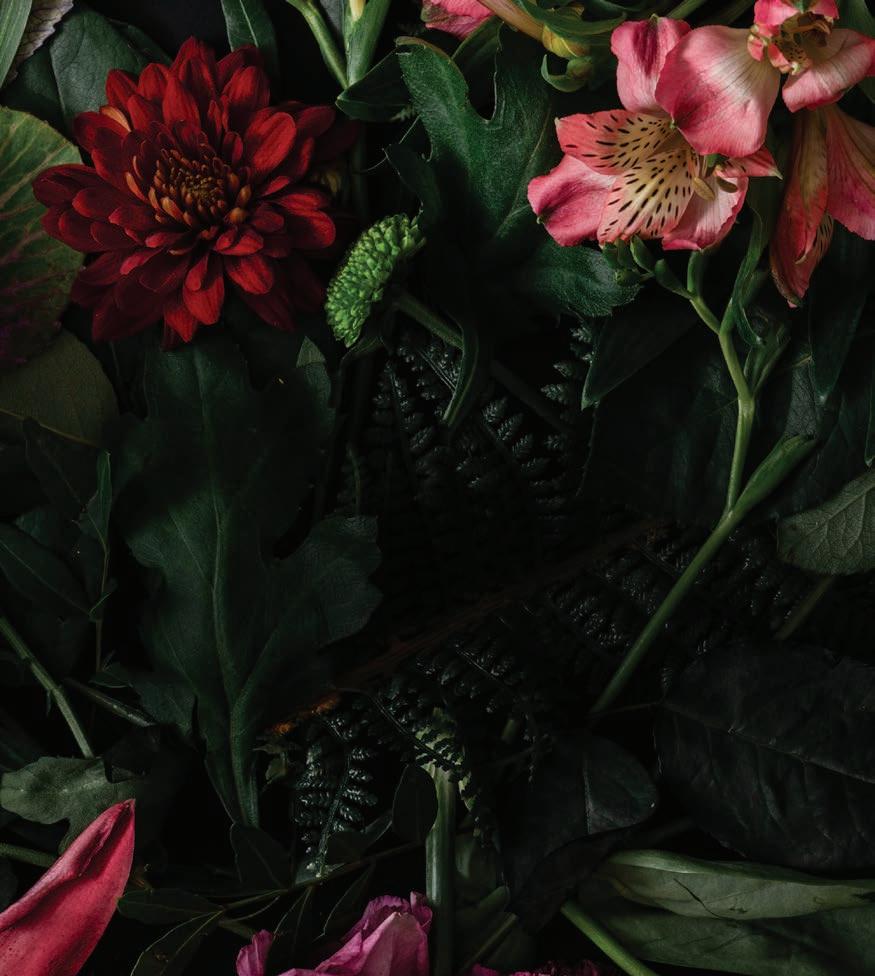


























A star-studded lineup of soloists joins the MSO and MSO Chorus for a rousing performance of Beethoven’s revolutionary Ninth Symphony, culminating in the epic finale, Ode to Joy.
28–30 NOVEMBER
Arts Centre Melbourne, Hamer Hall















SCREEN




THEATRE PROJECTIONOUTDOO R EVENTS






EVENT MANAGEMENT







PERFORMANCE RECORDING


LIVE CAMERA TO SCREEN






EVENT MANAGEMENT

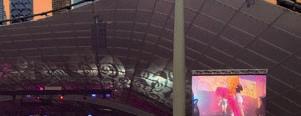
LIVE CAMERA TO SCREEN
CORPORATE COMMUNICATION PERFORMANCE RECORDING





PERFORMANCE RECORDING VIRTUAL R E A LITY







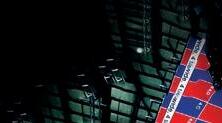




POST PRODUCTION


VIDEO PRODUCTION


THEATRE PROJECTION








CORPORATE COMMUNICATION



VIDEO PRODUCTION



THEATRE PROJECTION

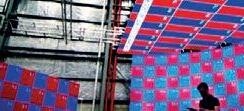



POST PRODUCTION


POST PRODUCTION EVENT MANAGEMENT


CORPORATE COMMUNICATION



PERFORMANCE RECORDING LIVE ST R EAMING






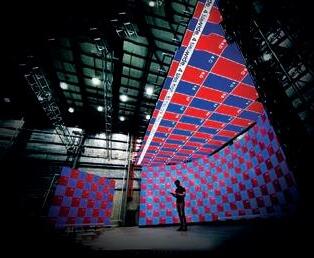


VIDEO PRODUCTION












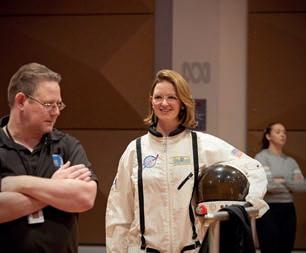

LIVE CAMERA TO SCREEN




POST PRODUCTION


EVENT MANAGEMENT




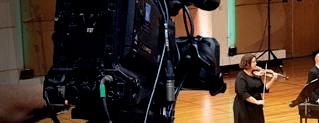

We present your business at its best…

VIDEO PRODUCTION



LIVE CAMERA TO SCREEN
POST PRODUCTION






CORPORATE COMMUNICATION






VIDEO PRODUCTION

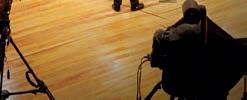
THEATRE PROJECTION
EVENT MANAGEMENT


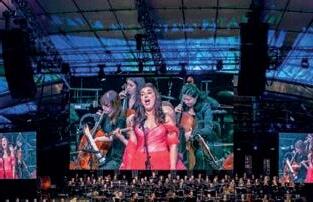
LIVE CAMERA TO SCREEN
MANAGEMENT CORPORATE PRODUCTION

LIVE CAMERA TO SCREEN PERFORMANCE RECORDING PROJECTION POST PRODUCTION EVENT MANAGEMENT
LIVE CAMERA TO SCREEN
CORPORATE COMMUNICATION PERFORMANCE RECORDING POST PRODUCTION
RECORDING VIDEO PRODUCTION LIVE CAMERA TO SCREEN POST PRODUCTION
CORPORATE COMMUNICATION PERFORMANCE THEATRE PROJECTION POST PRODUCTION EVENT MANAGEMENT CORPORATE COMMUNICATION VIDEO PRODUCTION LIVE EVENT MANAGEMENT CORPORATE COMMUNICATION PERFORMANCE RECORDING VIDEO PRODUCTION THEATRE PROJECTION POST PERFORMANCE RECORDING VIDEO PRODUCTION LIVE CAMERA TO SCREEN THEATRE PROJECTION POST PRODUCTION EVENT MANAGEMENT CORPORATE LIVE CAMERA TO SCREEN THEATRE PROJECTION POST PRODUCTION EVENT MANAGEMENT CORPORATE COMMUNICATION PERFORMANCE RECORDING









CVP Events, Film & Television is Australia’s leading complete vision solutions company
Whether we’re making a television commercial or a piece of corporate communication, recording your performance, using multiple projectors to create a 60metre wide image, providing live to screen services at your concert or managing the entire event for you — at CVP — each component of the event is handled by staff who are specialists in their field.
We believe in excellence — it’s reflected in everything we do.
Her Excellency Professor, the Honourable
Margaret Gardner AC, Governor of Victoria
The Gandel Foundation
The Gross Foundation
Besen Family Foundation
Di Jameson OAM and Frank Mercurio
Harold Mitchell Foundation
Lady Primrose Potter AC CMRI
Cybec Foundation
The Pratt Foundation
The Ullmer Family Foundation
Anonymous (1)
Chief Conductor Chair Jaime Martín
Supported in memory of Eva and
Marc Besen
Concertmaster Chair
David Li AM and Angela Li
Cybec Assistant Conductor Chair
Leonard Weiss CF
Cybec Foundation
Acting Associate Concertmaster
Tair Khisambeev
Di Jameson OAM and Frank Mercurio
Cybec Young Composer in Residence
Naomi Dodd
Cybec Foundation
Now & Forever Fund: International
Engagement Gandel Foundation
Cybec 21st Century Australian
Composers Program Cybec Foundation
First Nations Emerging Artist Program
The Ullmer Family Foundation
East meets West The Li Family Trust
Community and Public Programs
AWM Electrical, City of Melbourne, Crown Resorts Foundation, Packer Family Foundation
MSO Live Online and MSO Schools
Crown Resorts Foundation, Packer Family Foundation
Student Subsidy Program Anonymous
MSO Academy Di Jameson OAM and Frank Mercurio, Mary Armour, Christopher Robinson in memory of Joan P Robinson
Jams in Schools Melbourne Airport, Department of Education Victoria, through the Strategic Partnerships Program, AWM Electrical, Jean Hadges, Hume City Council, Rural City of Wangaratta, Marian and EH Flack Trust, and Flora and Frank Leith Trust.
Regional Touring AWM Electrical, Creative Victoria, Freemasons Foundation
Victoria, Robert Salzer Foundation, Sir Andrew and Lady Fairley Foundation
Sidney Myer Free Concerts Sidney Myer
MSO Trust Fund and the University of Melbourne, City of Melbourne Event Partnerships Program
Instrument Fund Catherine and Fred Gerardson, Tim and Lyn Edward, Joe White Bequest
PLATINUM PATRONS $100,000+
AWM Electrical
Besen Family Foundation
The Gross Foundation
Di Jameson OAM and Frank Mercurio
David Li AM and Angela Li
Lady Primrose Potter AC
Anonymous (1)
VIRTUOSO PATRONS $50,000+
Jolene S Coultas
Dr Harry Imber
Margaret Jackson AC Packer Family Foundation
The Ullmer Family Foundation Anonymous (1)
H Bentley
Shane Buggle and Rosie Callanan
Tim and Lyn Edward
Catherine and Fred Gerardson
The Hogan Family Foundation
Maestro Jaime Martín
Elizabeth Proust AO and Brian Lawrence
Sage Foundation
Lady Marigold Southey AC
The Sun Foundation
Gai and David Taylor
Weis Family
Anonymous (1)
$10,000+
Christine and Mark Armour
John and Lorraine Bates
Margaret Billson and the late Ted Billson
Jannie Brown
Krystyna Campbell-Pretty AM
Ken Ong Chong OAM
Miss Ann Darby in memory of Leslie J. Darby
Mary Davidson and the late Frederick Davidson AM
Andrew Dudgeon AM
Val Dyke
Jaan Enden
Kim and Robert Gearon
Dr Mary-Jane H Gething AO
Cecilie Hall and the late Hon Michael Watt KC
Hanlon Foundation
Peter Lovell
Dr Ian Manning
Rosemary and the late Douglas Meagher
Farrel and Wendy Meltzer
Opalgate Foundation
Ian and Jeannie Paterson
Hieu Pham and Graeme Campbell
Janet Matton AM & Robin Rowe
Liliane Rusek and Alexander Ushakoff
Glenn Sedgwick
Athalie Williams and Tim Danielson
Lyn Williams AM
The Aranday Foundation
Mary Armour
Alexandra Baker
Barbara Bell in memory of Elsa Bell
Bodhi Education Fund
Julia and Jim Breen
Nigel and Sheena Broughton
Janet Chauvel and the late Dr Richard Chauvel
John Coppock OAM and Lyn Coppock
Cuming Bequest
David and Kathy Danziger
Carol des Cognets
The Dimmick Charitable Trust
Equity Trustees
Bill Fleming
John and Diana Frew
Carrillo Gantner AC and Ziyin Gantner
Geelong Friends of the MSO
Dr Rhyl Wade and Dr Clem Gruen
Louis J Hamon OAM
Dr Keith Higgins and Dr Jane Joshi
David Horowicz
Geoff and Denise Illing
Dr Alastair Jackson AM
John Jones
Merv Keehn and Sue Harlow
Peter T Kempen AM
Suzanne Kirkham
Liza Lim AM
Lucas Family Foundation
Dr Jane Mackenzie
Morris and Helen Margolis
Dr Isabel McLean
Ros and Gary McPherson
The Mercer Family Foundation
Myer Family Foundation
Suzie and Edgar Myer
Anne Neil in memory of Murray A. Neil
Newton Family in memory of Rae Rothfield
Jan and Keith Richards
Dr Rosemary Ayton and Professor Sam Ricketson AM Andrew and Judy Rogers
Guy Ross
Kate and Stephen Shelmerdine Foundation
Helen Silver AO and Harrison Young
Brian Snape AM
Dr Michael Soon
P & E Turner
Mary Waldron
Janet Whiting AM and Phil Lukies
The Yulgilbar Foundation
Igor Zambelli
Anonymous (3)
ASSOCIATE PATRONS $2,500+
Barry and Margaret Amond
Carolyn Baker
Marlyn Bancroft and Peter Bancroft OAM
Janet H Bell
Alan and Dr Jennifer Breschkin
Drs John D L Brookes and Lucy V Hanlon
Lynne Burgess
Dr Lynda Campbell
Oliver Carton
Charles & Cornelia Goode Foundation
Simone Clancy
Kaye Cleary
Leo de Lange
Sandra Dent
Rodney Dux
Diane and Stephen Fisher
Alex Forrest
Steele and Belinda Foster
Barry Fradkin OAM and Dr Pam Fradkin
Anthony Garvey and Estelle O’Callaghan
Susan and Gary Hearst
Janette Gill
R Goldberg and Family
Goldschlager Family Charitable Foundation
Colin Golvan AM KC and Dr Deborah Golvan
Jennifer Gorog
Miss Catherine Gray
Marshall Grosby and Margie Bromilow
Mr Ian Kennedy AM & Dr Sandra Hacker AO
Amy and Paul Jasper
Sandy Jenkins
Jenny Tatchell
Melissa Tonkin & George Kokkinos
Dr Jenny Lewis
David R Lloyd
Margaret and John Mason OAM
Ian McDonald
Dr Paul Nisselle AM
Simon O’Brien
Roger Parker and Ruth Parker
Alan and Dorothy Pattison
Ruth and Ralph Renard
James Ring
Tom and Elizabeth Romanowski
Dr Ronald and Elizabeth Rosanove
Christopher Menz and Peter Rose
Marshall Segan in memory of Berek Segan
OBE AM and Marysia Segan
Steinicke Family
Christina Turner
Dawna Wright and Peter Riedel
Shirley and Jeffrey Zajac
Anonymous (3)
($1,000+)
Dr Sally Adams
Jessica Agoston Cleary
Helena Anderson
Margaret Astbury
Geoffrey and Vivienne Baker
Mr Robin Batterham
Justine Battistella
Michael Bowles & Alma Gill
Allen and Kathryn Bloom
Richard Bolitho
Joyce Bown
Elizabeth Brown
Stuart Brown
Suzie Brown OAM and the late Harvey Brown
Roger and Coll Buckle
Jill and Christopher Buckley
Dr Robin Burns and Dr Roger Douglas
Shayna Burns
Ronald and Kate Burnstein
Daniel Bushaway and Tess Hamilton
Peter A Caldwell
Alexandra Champion De Crespigny
John Chapman and Elisabeth Murphy
Joshua Chye
Breen Creighton and Elsbeth Hadenfeldt
Mrs Nola Daley
Panch Das and Laurel Young-Das
Caroline Davies
Michael Davies and Drina Staples
Sue and Rick Deering
John and Anne Duncan
Jane Edmanson OAM
Grant Fisher and Helen Bird
Frank Tisher OAM and Dr Miriam Tisher
Christopher R Fraser
Chris Freelance
Applebay Pty Ltd
David H Frenkiel and Esther Frenkiel OAM
Mary Gaidzkar
David I Gibbs AM and Susie O'Neill
Sonia Gilderdale
Dr Celia Godfrey
Dr Marged Goode
Hilary Hall, in memory of Wilma Collie
David Hardy
Tilda and the late Brian Haughney
Cathy Henry
Gwenda Henry
Anthony and Karen Ho
Rod Home
Lorraine Hook
Doug Hooley
Katherine Horwood
Penelope Hughes
Jordan Janssen
Shyama Jayaswal
Basil and Rita Jenkins
Jane Jenkins
Emma Johnson
Sue Johnston
Angela Kayser
Drs Bruce and Natalie Kellett
Akira Kikkawa
Dr Judith Kinnear
Dr Richard Knafelc and Mr Grevis Beard
Tim Knaggs
Professor David Knowles and
Dr Anne McLachlan
Dr Jerry Koliha and Marlene Krelle
Jane Kunstler
Ann Lahore
Kerry Landman
Janet and Ross Lapworth
Bryan Lawrence
Phil Lewis
Dr Kin Liu
Andrew Lockwood
Elizabeth H Loftus
Chris and Anna Long
Wayne McDonald and Kay Schroer
Lois McKay
Lesley McMullin Foundation
Dr Eric Meadows
Ian Merrylees
Sylvia Miller
Ian Morrey and Geoffrey Minter
Anthony and Anna Morton
Laurence O'Keefe and Christopher James
George Pappas AO, in memory of Jillian Pappas
Susan Pelka
Ian Penboss
Kerryn Pratchett
Peter Priest
Professor Charles Qin OAM and Kate
Ritchie
Eli and Lorraine Raskin
Michael Riordan and Geoffrey Bush
Cathy Rogers OAM and Dr Peter Rogers AM
Marie Rowland
Jan Ryan
Viorica Samson
Martin and Susan Shirley
P Shore
Janet and Alex Starr
Dr Peter Strickland
Joel and Liora Symons
Russell Taylor and Tara Obeyesekere
Margaret Toomey
Andrew and Penny Torok
Ann and Larry Turner
Dr Elsa Underhill and Professor Malcolm Rimmer
Jayde Walker
Edward and Paddy White
Nic and Ann Willcock
Lorraine Woolley
Dr Kelly and Dr Heathcote Wright
George Yeung
C.F. Yeung & Family Philanthropic Fund
Demetrio Zema
Anonymous (17)
Margaret Abbey PSM
Jane Allan and Mark Redmond
Jenny Anderson
Doris Au
Lyn Bailey
Robbie Barker
Peter Berry and Amanda Quirk
Dr William Birch AM
Robert Bridgart
Miranda Brockman
Dr Robert Brook
Robert and Katherine Coco
Dr John Collins
Warren Collins
Gregory Crew
Sue Cummings
Suzanne Dembo
Carol des Cognets
Bruce Dudon
Dr Catherine Duncan
Margaret Flatman
Brian Florence
Martin Foley
Elizabeth Foster
M C Friday
Simon Gaites
George Miles
David and Geraldine Glenny
Hugo and Diane Goetze
Louise Gourlay OAM
Dawn Hales
George Hampel AM KC and
Felicity Hampel AM SC
Alison Heard
Dr Jennifer Henry
C M Herd Endowment
Carole and Kenneth Hinchliff
William Holder
Peter and Jenny Hordern
Gillian Horwood
Oliver Hutton
Rob Jackson
Ian Jamieson
Wendy Johnson
Leonora Kearney
Jennifer Kearney
John Keys
Lesley King
Heather Law
Pauline and David Lawton
Paschalina Leach
David Willersdorf AM and Linda Willersdorf
Kay Liu
David Loggia
Helen McLean
Joy Manners
Sandra Masel in memory of Leigh Masel
Janice Mayfield
Gail McKay
Shirley A McKenzie
Richard McNeill
Marie Misiurak
Adrian and Louise Nelson
Marian Neumann
Ed Newbigin
Valerie Newman
Dr Judith S Nimmo
Amanda O’Brien
Jeremy O’Connor and Yoko Murakoshi
Brendan O’Donnell
Sarah Patterson
The Hon Chris Pearce and Andrea Pearce
William Ramirez
Geoffrey Ravenscroft
Dr Christopher Rees
Professor John Rickard
Fred and Patricia Russell
Carolyn Sanders
Dr Marc Saunders
Julia Schlapp
Madeline Soloveychik
Stephen and Caroline Brain
Allison Taylor
Hugh Taylor and Elizabeth Dax
Geoffrey Thomlinson
Mely Tjandra
Chris and Helen Trueman
Noel and Jenny Turnbull
Phil Parker
Rosemary Warnock
Amanda Watson
Michael Whishaw
Deborah and Dr Kevin Whithear OAM
Adrian Wigney
Charles and Jill Wright
Richard Ye
Anonymous (15)
Justine Battistella
Shayna Burns
Jessica Agoston Cleary
Alexandra Champion de Crespigny
Josh Chye
Akira Kikkawa
Jayde Walker
Demetrio Zema
MSO GUARDIANS
Jenny Anderson
David Angelovich
Lesley Bawden
Peter Berry and Amanda Quirk
Tarna Bibron
Joyce Bown
Patricia A Breslin
Jenny Brukner and the late John Brukner
Sarah Bullen
Peter A Caldwell
Luci and Ron Chambers
Sandra Dent
Sophie E Dougall in memory of Libby Harold
Alan Egan JP
Gunta Eglite
Marguerite Garnon-Williams
Dr Clem Gruen and Dr Rhyl Wade
Louis J Hamon OAM
Charles Hardman and Julianne Bambacas
Carol Hay
Dr Jennifer Henry
Graham Hogarth
Rod Home
Lyndon Horsburgh
Katherine Horwood
Tony Howe
Lindsay and Michael Jacombs
John Jones
Merv Keehn and Sue Harlow
Pauline and David Lawton
Robyn and Maurice Lichter
Christopher Menz and Peter Rose
Cameron Mowat
Laurence O’Keefe and Christopher James
David Orr
Matthew O’Sullivan
Rosia Pasteur
Penny Rawlins
Margaret Riches
Anne Roussac-Hoyne and Neil Roussac
Michael Ryan and Wendy Mead
Anne Kieni Serpell and Andrew Serpell
Jennifer Shepherd
Suzette Sherazee
Professors Gabriela and George
Stephenson
Pamela Swansson
Tam Vu and Dr Cherilyn Tillman
Frank Tisher OAM and Dr Miriam Tisher
Christina Helen Turner
Mr and Mrs R P Trebilcock
Michael Ullmer AO
The Hon Rosemary Varty
Francis Vergona
Tam Vu and Dr Cherilyn Tillman
Robert Weiss and Jacqueline Orian
Terry Wills Cooke OAM and the late
Marian Wills Cooke
Mark Young
Anonymous (23)
The MSO gratefully acknowledges the support of the following Estates:
Norma Ruth Atwell
Angela Beagley
Barbara Bobbe
Michael Francois Boyt
Christine Mary Bridgart
Margaret Anne Brien
Ken Bullen
Deidre and Malcolm Carkeek
The Cuming Bequest
Margaret Davies
Blair Doig Dixon
Neilma Gantner
Angela Felicity Glover
The Hon Dr Alan Goldberg AO QC
Derek John Grantham
Delina Victoria Schembri-Hardy
Enid Florence Hookey
Gwen Hunt
Family and Friends of James Jacoby
Audrey Jenkins
Joan Jones
Pauline Marie Johnston
George and Grace Kass
Christine Mary Kellam
C P Kemp
Jennifer Selina Laurent
Sylvia Rose Lavelle
Peter Forbes MacLaren
Joan Winsome Maslen
Lorraine Maxine Meldrum
Prof Andrew McCredie
Jean Moore
Joan P Robinson
Maxwell and Jill Schultz
Miss Sheila Scotter AM MBE
Marion A I H M Spence
Molly Stephens
Gwennyth St John
Halinka Tarczynska-Fiddian
Jennifer May Teague
Elisabeth Turner
Albert Henry Ullin
Jean Tweedie
Herta and Fred B Vogel
Dorothy Wood
Joyce Winsome Woodroffe
COMMISSIONING CIRCLE
Cecilie Hall and the Late Hon Michael Watt KC
Tim and Lyn Edward
FIRST NATIONS CIRCLE
John and Lorraine Bates
Equity Trustees
Colin Golvan AM KC and Dr Deborah Golvan
Elizabeth Proust AO and Brian Lawrence
Guy Ross
The Sage Foundation
Michael Ullmer AO and Jenny Ullmer
Margaret Billson and the late Ted Billson
Peter Edwards
Shane Buggle and Rosie Callanan
Roger Young
Andrew Dudgeon AM
Rohan de Korte, Philippa West
Tim and Lyn Edward
John Arcaro
Dr John and Diana Frew
Rosie Turner
Dr Mary-Jane Gething AO
Monica Curro
The Gross Foundation
Matthew Tomkins
Dr Clem Gruen and Dr Rhyl Wade
Robert Cossom
Jean Hadges
Prudence Davis
Cecilie Hall
Patrick Wong
Cecilie Hall and the late Hon Michael Watt KC
Saul Lewis
The Hanlon Foundation
Abbey Edlin
David Horowicz
Anne Marie Johnson
Dr Harry Imber
Sarah Curro, Jack Schiller
Margaret Jackson AC
Nicolas Fleury
Di Jameson OAM and Frank Mercurio
Elina Fashki, Benjamin Hanlon, Tair Khisambeev, Christopher Moore
Peter T Kempen AM
Rebecca Proietto
Morris and Helen Margolis
William Clark
Rosemary and the late Douglas Meagher
Craig Hill
Professor Gary McPherson
Rachel Shaw
Anne Neil
Eleanor Mancini
Newton Family in memory of Rae Rothfield
Cong Gu
Patricia Nilsson
Natasha Thomas
Andrew and Judy Rogers
Michelle Wood
Glenn Sedgwick
Tiffany Cheng, Shane Hooton
Anonymous
Rachael Tobin
Life Members
John Gandel AC and Pauline Gandel AC
Jean Hadges
Sir Elton John CBE
Lady Primrose Potter AC CMRI
Jeanne Pratt AC
Lady Marigold Southey AC
Michael Ullmer AO and Jenny Ullmer
MSO Ambassador
Geoffrey Rush AC
The MSO honours the memory of Life Members
The late Marc Besen AC and the late Eva Besen AO
John Brockman OAM
The Honourable Alan Goldberg AO QC
Harold Mitchell AC
Roger Riordan AM
Ila Vanrenen
Jaime Martín
Chief Conductor
Benjamin Northey
Principal Conductor and Artistic Advisor –Learning and Engagement
Leonard Weiss CF
Cybec Assistant Conductor
Sir Andrew Davis CBE †
Conductor Laureate (2013–2024)
Hiroyuki Iwaki †
Conductor Laureate (1974–2006)
Warren Trevelyan-Jones
MSO Chorus Director
Erin Helyard
Artist in Residence
Karen Kyriakou
Artist in Residence, Learning and Engagement
Christian Li
Young Artist in Association
Katy Abbott
Composer in Residence
Naomi Dodd
Cybec Young Composer in Residence
Deborah Cheetham Fraillon AO
First Nations Creative Chair
Artistic Ambassadors
Xian Zhang
Lu Siqing
Tan Dun
Chairman
David Li AM
Co-Deputy Chairs
Martin Foley
Di Jameson OAM
Board Directors
Shane Buggle
Andrew Dudgeon AM
Lorraine Hook
Margaret Jackson AC
Gary McPherson
Farrel Meltzer
Edgar Myer
Mary Waldron
Company Secretary
Demetrio Zema
The MSO relies on your ongoing philanthropic support to sustain our artists, and support access, education, community engagement and more. We invite our supporters to get close to the MSO through a range of special events.
The MSO welcomes your support at any level. Donations of $2 and over are tax deductible, and supporters are recognised as follows:
$500+ (Overture)
$1,000+ (Player)
$2,500+ (Associate)
$5,000+ (Principal)
$10,000+ (Maestro)
$20,000+ (Impresario)
$50,000+ (Virtuoso)
$100,000+ (Platinum)
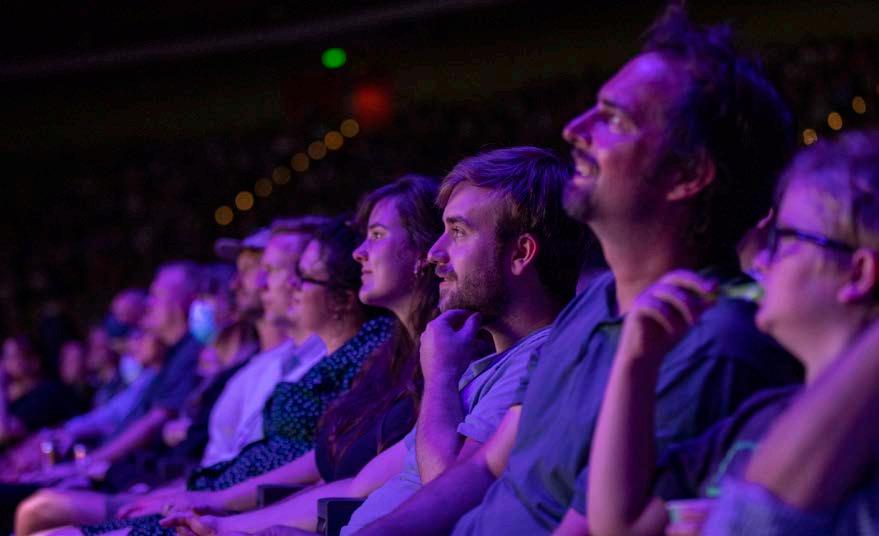
Join a new generation of giving.
Welcome to Future MSO – an initiative for young philanthropists and music lovers to connect over exclusive opportunities, while supporting the careers of exceptional emerging musicians, conductors and composers at the MSO.
Your tax time donation of $1,000 reveals:
• A community of like-minded, culturally engaged young professionals.
• An annual calendar of events for you and a guest to connect with patrons, MSO musicians and guest artists.
• The inner world of the Orchestra with experiences that bring you closer to the music.
AMPLIFY YOUR IMPACT BY JOINING FUTURE MSO TODAY.

Scan the QR code to join Future MSO today. Or email philanthropy@mso.com.au to discuss your involvement.
PREMIER PARTNER
VENUE PARTNER
INTERNATIONAL LAW FIRM PARTNER
MAJOR PARTNERS
GOVERNMENT PARTNERS

EDUCATION PARTNERS
ORCHESTRAL TRAINING PARTNER

SUPPORTING PARTNERS









